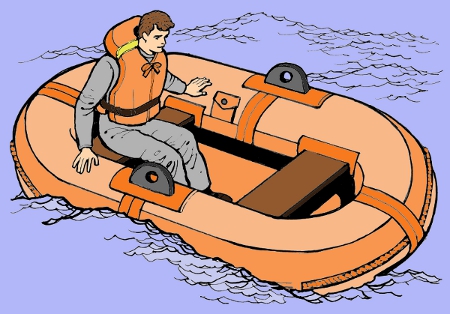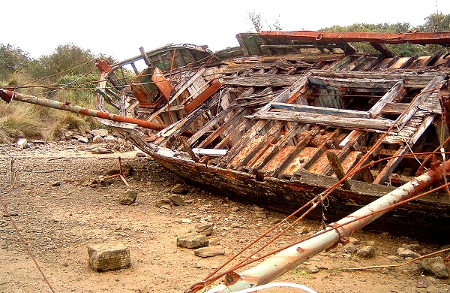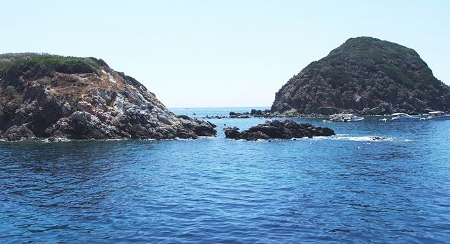Activity: Shipwreck Survival

(Courtesy of the Museum of Science, Boston).
Level: Students in grades 4-10. Time Required: 30 minutes for activity plus 5 minutes for set up and 5 minutes for clean up. Downloadable teacher worksheet pdf.
Design Challenge: Shipwreck Survival
Introduction
Do your students have what it takes to survive and be rescued? Working in small teams, students practice the creative design thinking and practical skills of engineers as they devise survival tools from materials provided in their supplies crate. They learn about teamwork, brainstorming, innovation, and creative material reuse in attempted to create a protective shelter, a method for gathering food, and a signal for help. Once they come up with their designs, the teams test them out for feasibility before having a design review with their teacher and the rest of the class.
Design Challenges is a Museum of Science program intended to introduce students to the engineering design cycle. Visitors participate in a hands-on activity to design, build, and test a prototype solution to a given problem, having a fun and engaging experience with engineering and innovation processes. Please see the Website for description of other design challenges and downloadable activities.
Materials
(per Team):
- Design Challenge Worksheet*
- Wooden Crate
- Map of the Island
- Shower Curtain
- Small Fleece Blanket
- Plastic Sand Toy (e.g., a rake)
- Camping Clothesline
- Two Feet of Aluminum Foil
- Pipette Holders
- Ice Tray
- Plastic Tie Rack
- Cardboard Tube
- Bungee Cords
- Rope (3 lengths)
- Fresnel Lens
- Scrap Paper
Goal
Working in small teams, students design, build and test solutions to survive on a deserted island.
Directions
1. Ask: Divide students into small design teams of 3 or 5 members and explain the shipwrecked scenario. Give each team one Design Challenge Worksheet, scrap paper, and one crate of materials with which to work.
Tell the students: Think about the kinds of tools you would need to survive being shipwrecked on a deserted island. Examine the materials you
have in your survival crate and think about how you could create
each of the items from the following list:
- A lifesaving device
- A tool for gathering food
- A signal for help
- Waterproof storage for food and supplies
- A method for collecting water
- Entertainment while on the island
- Protective footwear
- A shelter from the sun and rain
2. Imagine: Have each team examine the contents of their crate, the map of the island, and the list of items they need to build. Students should brainstorm ideas to create the survival items using only the supplied materials and any natural resources they can find on the island. Students should not start building until after the plan phase.
Tell the students: Brainstorm many different ideas about how to construct each of the survival items. Share ideas with your group.
3. Plan: Students should sketch their designs on the scrap paper. Older students can be directed to ensure that they do not use a material more than once and that they devise a use for each item on the list. If students get stuck for ideas, suggest that they either examine their materials and brainstorm ways to use them, or imagine solutions, and then see which materials might let them implement those solutions.
Tell the students: As a team, pick the design ideas you like best, and plan which materials you will use for each design. Try and create as many tools from the list as you can with only the objects in your crate.
4. Create: Using the materials provided and imagining any natural resources, students should now construct the items they would need to survive if they were shipwrecked on a deserted island. Have students present some or all of their designs to the class and then get feedback on their designs. This process of design review is a critical step for professional engineers.
Tell the students: Build your inventions according to the plans you created with your team. Experiment using your devices to see if they will hold up or need improvement. Prepare to present your designs before the class.
5. Improve: After getting feedback from the design review, students should redesign their items. As they do so, encourage the groups to make appropriate changes to the sketch of their model, so that these depictions reflect their new designs.
Tell the students: What could you do to make your invention better? What
would you add to it? What kinds of additional materials would you like to use?
Upon completing their final designs, students should be directed to reflect upon the materials and designs that worked best for achieving their goals. How did they come up with ideas, particularly those that were harder for them? Ask them to then consider a next step for their design process.
Facilitation Tips
- The work space should have structures on which to build. For example, benches or desks can be used in place of trees to hold up a tarp.
- The Materials List provided is merely a suggested list. If other materials seem to suit this activity, feel free to adjust the list accordingly. Try to consider materials that don’t have an obvious use, so students will be forced to be imaginative. Make sure students have at least one solution for each type of item they are to design.
- To shorten this activity, reduce the number of supplies that students need to build or omit the design review presentations.
- Be sure that students understand the limitations of living on a deserted island and plan their designs accordingly. For example, they can’t drink ocean water and cell phones won’t work.
- Design reviews emphasize the importance of communicating ideas in
science and technology.
*The worksheet was designed as a museum activity and may need to be modified by the teacher, as has been done here.
This project is funded through the Institute of Museum and Library Services by an Act of Congress, in accordance with the FY2004 Consolidated Appropriations bill.
Filed under: Class Activities, Grades 6-8, Grades K-5










